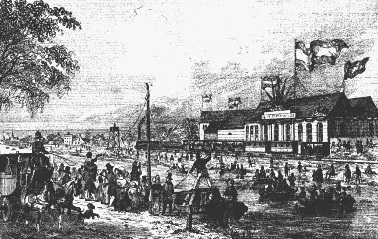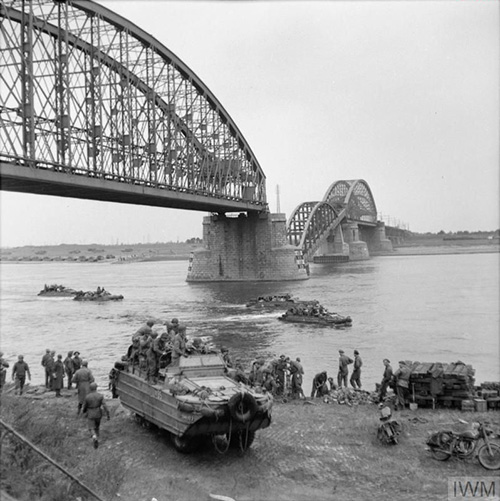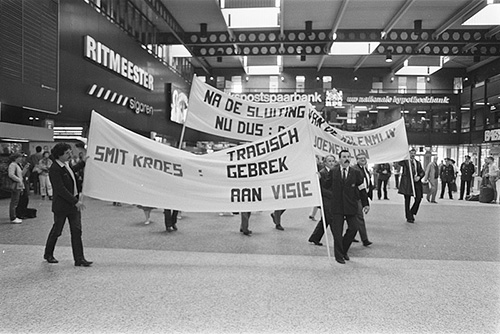

 STUART JORDAN looks at the development of railways in the Netherlands.
STUART JORDAN looks at the development of railways in the Netherlands.
Historically the Netherlands was a sea trading nation, with the Dutch East India Company opening commerce between Europe and India and Africa in the 17th and 18th centuries. The movement of goods through the country was already served by rivers and canals.
An ex-soldier named WA Bake was inspired by the railways opening in Britain. He came up with a plan to open a line between Amsterdam and Cologne. The powerful shipping lobby actively worked against the plans to build railways, so that they could keep their monopoly on the movement of goods. The lobby won, and Bake gave up his plans.

The first Dutch train leaves Amsterdam.
The Dutch king, William I, worried that the country was lagging behind other European powers who were also building railways. Many investors saw the virtue in a line between the ports of Amsterdam and Rotterdam. English engineers were imported to build the railways, but bizarrely 1945mm Broad Gauge was used instead of the more prevalent Standard Gauge. This meant that any Dutch line built didn't match with neighbouring countries. On September 20th, 1839 the first train ran from Amsterdam to Haarlem to much fanfare, with commercial traffic started four days later.
Two main companies emerged as the main builders of Dutch railways; Hollandsche IJzeren Spoorweg-Maatschappij (HSM, "Hollands Iron Railway-Company"), and the Nederlandse Rhijnspoorweg-Maatschappij (NSR, "Netherlands Rhine Railway-Company").
The first line was extended by HSM to Rotterdam, reaching the port city in 1847. The main objective of the NSR was to extend the railway from Amsterdam into Germany. They found getting investment difficult, with the king again stepping in to help support the venture. The line connected Amsterdam to Utrecht (1843), through to Arnhem (1845), and on to Germany by 1856. The final connection took so long because, as mentioned earlier, the first Dutch railways were built to Broad Gauge. The whole network was converted to Standard Gauge in the 1850s, allowing the connection to the German network without a change of gauge.
As in most other countries, the initial frenzy of railway building was carried out by mostly unregulated private companies. With an eye on commercial viability rather than general public service, the railways mostly sprung up around the most populated parts of Holland. Some communities left behind by the railway boom lobbied the government to bring the tracks to their town.
In 1860 the government decided to change this and instituted a plan for a government-built spoorwegwet (railway system). Rather than just subsidising certain lines, this meant that the government would build and run their own network built on efficiency and connecting as many points on the map as possible. Station designs and other parts of the infrastructure were standardised. Despite being a state-designed system, it was actually built and run by a new private company, Maatschappij tot Exploitatie van Staatsspoorwegen (SS, "Company for the Exploitation of the State Railways"). At the same time, other private companies were still building their own lines. This expansion continued until the early part of the 20th Century, with electrification starting in 1908.
After the First World War the SS and the HSM fell into decline. The two companies started to cooperate in order to stay afloat, as there would have been disastrous consequences if the two largest railway companies in the country had failed. In 1938 the government formally merged them into the Nederlandse Spoorwegen (NS).

Oosterbeek Railway Bridge, destroyed by the Germans during Operation Market Garden - the operation immortalised in 'A Bridge Too Far'.
During the Second World War the NS was forced by the Nazis to assist in the deportation of Jews. In 2018 NS would begin to pay compensation to Holocaust survivors and relatives of those transported to the Westerbork camp - the company described the event as a 'black page in the history of the company and country'.
The Post-War period was a time of reconstruction, as the economies and infrastructure of Europe had to be renewed after seven years of war. The 1960s saw a worldwide decline in the use of trains, as the motor car became much more prevalent. The discovery of a natural gas source meant that power stations in the country moved away from coal, which traditionally was moved by rail. By 1970 NS had to do something to stop the decline. More trains were added to the timetable and intercity services were introduced. Despite these changes, NS still received a substantial amount of government subsidies to stay afloat.
These subsidies started to be questioned in the 1990s, and reforms were made. To begin with, the large generic subsidies of the 1980s were stopped and a more forensic approach was taken - helped by an EU directive which split infrastructure and transport on the railways into two separate companies. The infrastructure would be run by the government, and NS would run the passenger services as a commercial operation. There would be competition on the railways, and any poor performing lines would be subsidised by the government.
Further splits of the NS into autonomous divisions were shelved after widespread opposition by the unions. Further problems were caused when NS Cargo became a part of Deutsche Bahn, with wildcat strikes bringing the company to its knees. The whole board of directors resigned in 2001. The reforms were mostly reversed by the new CEO, and NS was given a concession by the government to run the main lines.

Striking workers protesting against reforms to the railway service.
The smaller lines were run by other private companies - the aim was to remove the competitive element from the market to improve service. In 2006 a clockface timetable was introduced to improve connections. German ICE High Speed Trains run between Frankfurt and Amsterdam, linking there with other international expresses such as the Thalys and Eurostar, where services continue onto destinations in Switzerland, France, and Great Britain.

Piko are the company who produce the most stock for the NS, including the famous Hondekop (dog's head) EMU (above) in both HO and N Scales. They produce several starter sets in HO Scale, some of which include the Piko SmartControl DCC system. Preiser can provide you with a PR10213 set of Dutch Railway Staff.
International travellers can be represented by Eurostar trains in N Scale from Kato, and from the ICE Trains made in various scales by other companies such as Fleischmann, Roco, Marklin, Trix, Piko, and from Kato. Even British steam stock can be used, as various Austeritys ran in the Netherlands as well after the Second World War. British Railway Class 11s were used 'on the continent' as the NS Class 600, and the ubiquitous Class 66 is a common sight.